Timeless for almost 70 years, the BeyerDynamic M160 returns in a revised edition. New design, same technology: does this double ribbon microphone still deserve its legendary status?

How? A test of the M160 when its new edition already dates back to 2023? Yes. Because, if we weren’t able to test the famous Beyerdynamic back then, let’s take advantage of this series on ribbon microphones to repair this oversight.
The history and technical particularities of the M160
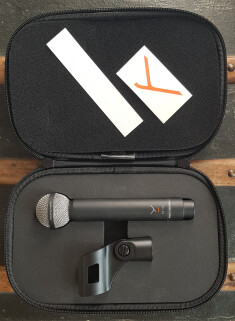
But that’s not all: the M160 offers a wider frequency response (up to 18kHz, where a Coles, for example, drops drastically from 15kHz) with a much better controlled proximity effect (as opposed to an RCA 44, which often forces you to keep a certain distance from the source to avoid a predominance of the low midrange). The result is a more detailed, natural and open sound, without the need for additional equalization.
It also stands out from its brethren by its design. Thinner and, above all, far less heavy, the M160's body moves away from the more imposing standards of the time (Coles, RCA or other Melodium) and is closer to that of a small, pencil-shaped dynamic, providing much more flexible overall ergonomics, with easy placement.
Furthermore, Beyerdynamic had the good idea of marketing a second ribbon microphone when it first released the M-160, the bidirectional M130. When it’s combined with the M160, the two mics create an entirely “ribbon” M-S pair, with the M160 acting as mid and the M130 as side.
Now let’s jump back in time to 2023. The German brand decided to revamp and update the entire “M” series ( M88, M201, M160, etc.) with a new, more modern logo, new, stronger packaging and a very slightly updated look. But the technology remains intact and the microphone is still assembled by hand: the M160 is dead, long live the M160 “2023."
Why the M160's “Red Dots” are far from decorative

For optimum response, Beyerdynamic recommends paying close attention to microphone placement and, above all, to the position of these two red dots. I quote from the manual (for whom the dots are orange… please excuse my color blindness…): “The two orange dots on the grille ring mark the longitudinal axis of the two ribbons. When using the microphone on tripods, care should normally be taken to ensure that this axis is in the vertical direction.”
I must confess that I rarely pay attention to this during a session. Having talked about it with several other sound engineers, and although they all found it quite logical, few seemed to be (or to have been) really attentive to it either. Some even seemed surprised, while others argued that in close proximity, the difference should be smaller. Well… When theory meets practice…The more astute will notice in some photos that I haven’t necessarily followed Beyer’s recommendations. Rest assured, these are only illustrative photos, and the red (or orange?) dots were vertical when the sound was recorded for this article!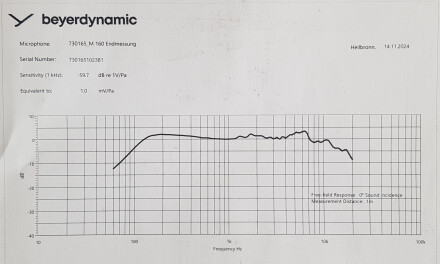
The M160 facing the drums: clarity and balance put to the test
Now let’s get down to audio testing, comparing the Beyer with an AKG C414, priced close to the M160 and whose linearity will enable us to better perceive the color and impact of the ribbon on the sound. To spice up the exercise, an “old" M160, dating from the 2000s and perfectly maintained (but whose double ribbon has never been changed) will also be on hand.
Front position
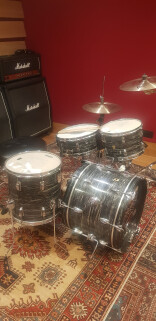
The lower end of the spectrum is less prominent than you’d expect from a ribbon. However, it remains present, precise and concise, restoring the sound of the bass drum in a fairly realistic way, even if it might lack sub for lovers of low frequencies. As for cymbals, their reproduction is truly exceptional, with air and yet no aggressiveness. It’s easy to see why this pickup is so often used close to ride, crash or hi-hat, or even in the overhead position to encourage cymbal playing without too much kick replay or too invasive a low midrange.
In the Room position
As a room mic, the M160 is as convincing as ever, with a very musical and well-balanced result. Typical but neither too fat nor too dull. The perfect middle ground. The drums, and especially the snare drum, gain in depth with a woody side that you don’t feel with the C414.
In comparison, the “old” version retains the same overall color, yet with less dynamics and a less generous sound. This underscores the impact that ribbon life can have on the reproduction quality of a microphone.
With high compression
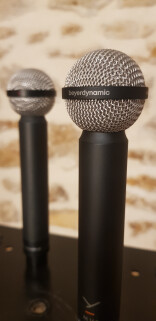
Although the room isn’t gigantic, the ribbon then accentuates the “roomy” side of the plug very well. Surprisingly, the old M160 also comes into its own once compression is activated, with a slightly dirtier and more teasing rendering that further typifies the take.
For fans of the old M160, the ribbon is an excellent choice.
For fans of anecdotes, you should know that the drum sound of Led Zeppelin’s “When The Levee Breaks” is due mainly to two M160s positioned in ambience.

- 01a Drums Front Akg C41400:17
- 01b Drums Front M160 202300:17
- 01c Drums Front M160 Old00:17
- 02a Drums Room Akg C41400:17
- 02c Drums Room M160 202300:17
- 02c Drums Room M160 Old00:17
- 03a Drums CompExtreme C41400:16
- 03b Drums CompExtreme M160 202300:16
- 03c Drums CompExtreme M160 Old00:16
Piano and glockenspiel: test of precision and smoothness
With an upright piano
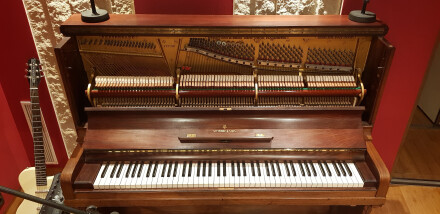
While from a technical point of view, the C414 sounds better, the color of the Beyerdynamic becomes extremely interesting in the context of a song (vintage or otherwise) to insert itself directly into your mix. It will never get in the way/compete with other instruments, whether in a low register (strings or bass) or high (vocals, brass, synths or lead guitars). And always with a certain cachet, perfect for typifying the sound as soon as it’s picked up. Its directionality could even make it a microphone of choice for piano-vocal recording, to reduce the crosstalk.
The only drawback is that the M160 requires a lot of gain from the preamp. Its rather low signal-to-noise ratio obviously makes it not the ideal microphone for pianissimo pieces.
.

- 04a C414 Piano A100:22
- 04b M160 2023 Piano A100:22
- 04c M160 Old Piano A100:22
- 05a C414 Piano A200:12
- 05b M160 2023 Piano A200:12
- 05c M160 Old Piano A200:12
On a Glockenspiel-toy
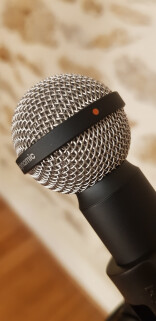

- 06a Schoeps Glock00:15
- 06b M160 2023 Glock00:15
- 06c M160 OLD Glock00:15
- 07a Schoeps Glock LoCut 400Hz00:15
- 07b M160 2023 Glock LoCut 400Hz00:15
- 07c M160 OLD Glock LoCut 400Hz00:15
On electric guitar: between bite and naturalness
Guitars
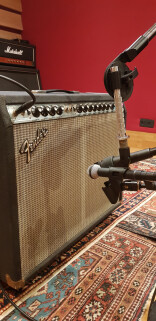
On palm muted or fuzz guitar, the M160's low midrange reveals itself a little more and then brings even more thickness while still retaining that beautiful balance. The sound remains warm and relatively natural, whereas a Royer R121 sounds more muted and fat, much more typical. Like the Royer, the M160 also pairs very well with the SM57 for an even peppier result.
As for the change in preamp impedance, it does indeed have an impact on microphone rendering. This will always generate the same question: which setup suits your ears and/or the song best?

- 08a Elec Gtr Surf Sm5700:22
- 08b Elec Gtr Surf M160 202300:22
- 08c Elec Gtr Surf M160 old00:22
- 08d Elec Gtr Surf R12100:22
- 08e Elec Gtr Surf M160 2023 + Sm5700:22
- 09a Elec Gtr PalmMute Sm5700:23
- 09b Elec Gtr PalmMute M160 202300:23
- 09c Elec Gtr PalmMute M160 Old00:23
- 09d Elec Gtr PalmMute R12100:23
- 09e Elec Gtr PalmMute M160 2023 + Sm5700:23
- 10a Elec Gtr Fuzz Sm5700:24
- 10b Elec Gtr Fuzz M160 202300:24
- 10c Elec Gtr Fuzz M160 Old00:24
- 10d Elec Gtr Fuzz R12100:24
- 10e Elec Gtr Fuzz M160 2023 + Sm5700:24
- 10f Elec Gtr Fuzz M160 2023 LoZ00:24
And Wurli
As a little bonus, here’s also a take on a Wurlitzer, plugged into an old Fender. The result is as conclusive as ever. Slightly fatter and less cutting than the SM57, the M160 is consistently excellent for miking amplified instruments.

- 11a Wurli Sm5700:09
- 11b Wurli M160 202300:09
- 11c Wurli M160 Old00:09
brass-and-voice: warmth, sweetness, but not too vintage
Facing a trumpet
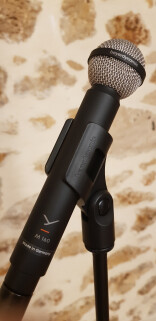
At this point, it’s rather amusing to note that the slightly pinched sound of the old M160 seems perfect on the “Peach” plug to bring back a slightly more dapper, gleaming color, often useful for boosting a brass section. Just goes to show, even microphones with slightly worn ribbon(s) can be valuable tools when used to good effect.

- 12a Tpt 414 Dry00:12
- 12b Tpt 160 2023 Dry00:12
- 12c Tpt 160 Old Dry00:12
- 13a Tpt + Fx C41400:15
- 13b Tpt + Fx M160 202300:15
- 13c Tpt +Fx M160 Old00:15
- 14a Tpt Peche C414 Dry00:04
- 14b Tpt Peche M160 2023 Dry00:04
- 14c Tpt Peche M160 Old Dry00:04
- 15a Tpt Peche + Fx C41400:07
- 15b Tpt Peche + Fx M160 202300:07
- 15c Tpt Peche + Fx M160 Old00:07
In front of a singer
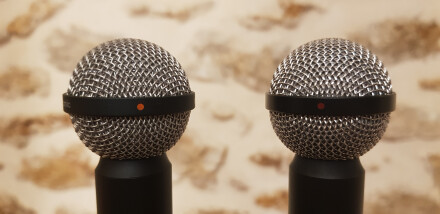
Colorful but not vintage or outdated, the sound remains natural and modern. In the “discographic references” series, a certain David Bowie used this very microphone for some of the vocals on his “Young Americans” album. Or the art and manner of showing once again the versatility of this microphone, typified, but certainly not stuck in a single sonority.
A remote pickup accentuates the differences between AKG and Beyerdynamic a little more, and even more those between the two versions of the M160, with the older one then revealing a much narrower sound. Is it enough to make me want to change the ribbons on my old M160?

- 16a Voix Male C41400:19
- 16b Voix Male M160 202300:19
- 16c Voix Male M160 Old00:19
- 17a Voix Male Far C41400:19
- 17b Voix Male Far M160 202300:19
- 17c Voix Male Far M160 Old00:19
Caracteristiques techniques
-
Type: dual ribbon microphone
-
Directivity: hypercardioid
-
Frequency response: up to 18 kHz
-
Sensitivity: low, requires a preamp with plenty of gain
-
Design: slim, compact and lightweight format
-
Accessories: suspension and carrying case supplied
-
Hand-assembled in Germany
-
Can be coupled with the M130 for full ribbon M/S sockets
FAQ
Is the Beyerdynamic M160 suitable for weak sources?
Not really: its low signal-to-noise ratio means you need a quiet, powerful preamp. For pianissimo takes, you’d be better off with another microphone.
Can it be used for modern recordings?
Yes! Even though it’s typical, the M160 doesn’t sound “vintage”. It offers a good spectral balance and openness that make it relevant in many modern contexts.
What do the famous red dots on the grille add?
They indicate the longitudinal axis of the ribbons, to be oriented vertically for optimum response. Basically: don’t ignore them.
What’s the difference between the M160 version 2023 and older models?
The design has been slightly updated, and the packaging modernized. The sound remains broadly the same, although older models often have a pinchier sound, especially if the ribbons are not replaced.
Can it be used alone on guitar jacks?
Yes, but it also goes very well with an SM57 if you want more bite. It gives a warm, mellow sound, but not a “fat” one.


